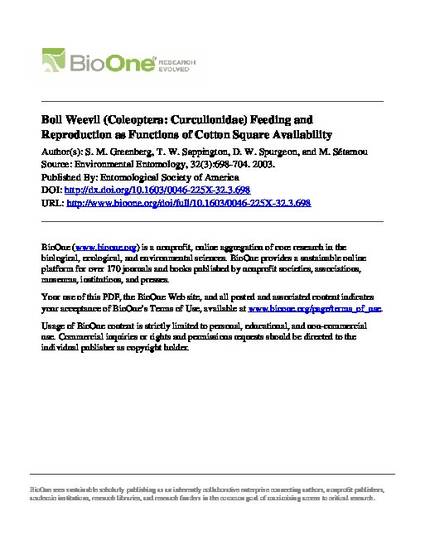
The influence of food item availability on boll weevil, Anthonomus grandis grandis Boheman, feeding and reproduction was determined by providing different numbers of cotton squares (flower buds) to individual weevils. Squares were replaced daily after a 5-d feeding and mating conditioning period. The number of lifetime punctures produced by boll weevil females and males increased with square availability. The total number of punctures caused by boll weevil females was 2.7-fold higher than that caused by males. Fecundity was significantly higher in the 10:1, 15:1, and 20:1 (squares:female) treatments than in the 1:1 treatment. The relationship between eggs laid per day and the square to female ratio significantly changed over the life of the female, with the largest differences among treatments occurring in the first 3 wk of adulthood. Survival of weevil progeny to adulthood was about two-fold higher in the 10:1, 15:1, and 20:1 treatments than in the 1:1 and 5:1 treatments. When each boll weevil female was provided 10, 15, or 20 cotton squares per day, estimates of a population growth index (percent of immatures surviving to adulthood divided by immature development time) and the exponential rate of increase (rm) were significantly higher than for those provided only one or five squares per day. Boll weevil populations maintained at a square:weevil ratio of 10:1 or above will increase >60-fold each generation (Ro), a rate significantly higher than that exhibited under 5:1 or 1:1 square:female regimens. These data show that daily provision of 10 squares per female provides sufficient resources to elicit a maximal oviposition response in the laboratory. Our results also will be useful in predicting changes in boll weevil populations relative to crop phenology and starting population density.
Available at: http://works.bepress.com/thomas_sappington/46/

This article is from Environmental Entomology 32 (2003): 698, doi:10.1603/0046-225X-32.3.698.